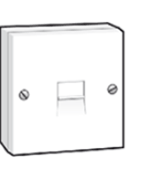The primary phone socket is the socket where the phone line enters your home, usually found in the hallway near the front door. If you can't find it, have a look outside for any wires entering your home, then look for a white box on the wall inside.
If you are a fibre customer you might not use a primary socket, instead an Openreach Modem (or ONT) connects your house to our fibre optic network. Find out more about the Openreach modem
If you have more than one socket, the primary socket is the one that will feed any extension sockets. It's always best to connect your BT Hub to the primary socket if you can. This is where the broadband signal is strongest, before it goes through any other home wiring which could cause interference.
This is usually what an extension socket looks like. If all your sockets look like this, then one of them will be your primary socket. It's most likely to be the one nearest where your line comes into your home.

Primary socket with a single socket
If your primary socket has one socket, like this:

You must use a microfilter for every phone socket in your home with any phone or broadband equipment plugged in (including your Hub, phones, answer machines, digital TV boxes, and alarm systems).
A microfilter is a device that allows broadband to work at the same time as your phone service. If you need to order more microfilters go to www.bt.com/shop >

Primary socket with two sockets
If your primary socket has two sockets, like this:

This means that the line is already split between your phone and broadband, so you don't need microfilters - not for your Hub or any other devices connected to phone sockets or extensions.
You must always plug your Hub into the broadband connection on your main socket. If you plug it into a phone socket or extension, it just won't work.
